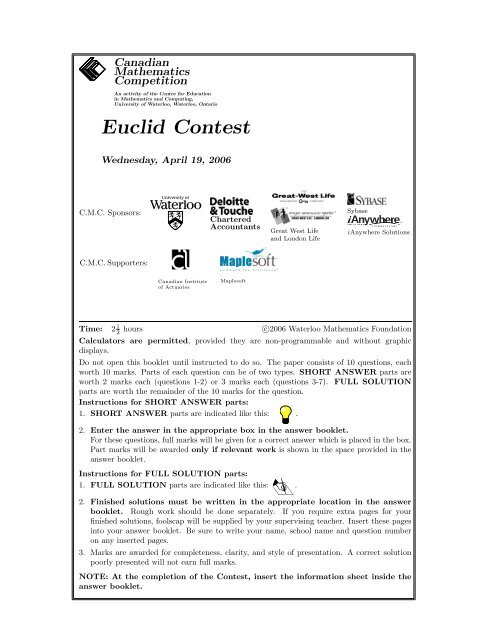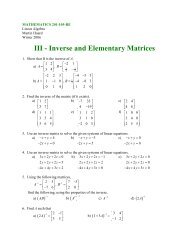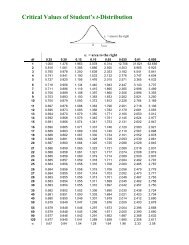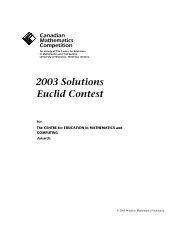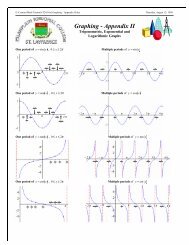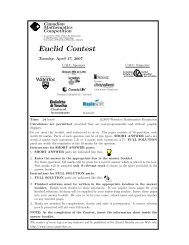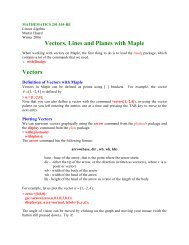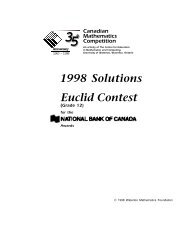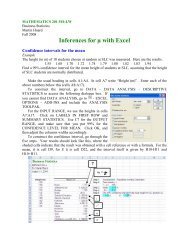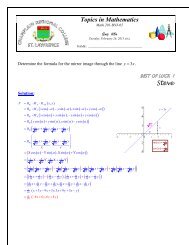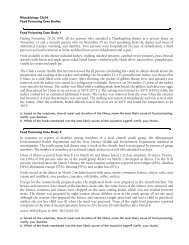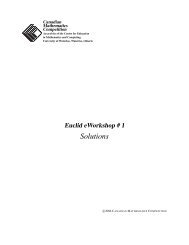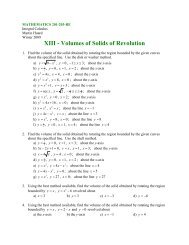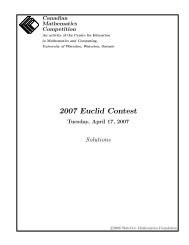Euclid Contest 2006 - CEMC - University of Waterloo
Euclid Contest 2006 - CEMC - University of Waterloo
Euclid Contest 2006 - CEMC - University of Waterloo
Create successful ePaper yourself
Turn your PDF publications into a flip-book with our unique Google optimized e-Paper software.
Canadian<br />
Mathematics<br />
Competition<br />
An activity <strong>of</strong> the Centre for Education<br />
in Mathematics and Computing,<br />
<strong>University</strong> <strong>of</strong> <strong>Waterloo</strong>, <strong>Waterloo</strong>, Ontario<br />
<strong>Euclid</strong> <strong>Contest</strong><br />
Wednesday, April 19, <strong>2006</strong><br />
C.M.C. Sponsors:<br />
Chartered<br />
Accountants<br />
Great West Life<br />
and London Life<br />
Sybase<br />
iAnywhere Solutions<br />
C.M.C. Supporters:<br />
Canadian Institute<br />
<strong>of</strong> Actuaries<br />
Maples<strong>of</strong>t<br />
Time: 2 1 2<br />
hours c○<strong>2006</strong> <strong>Waterloo</strong> Mathematics Foundation<br />
Calculators are permitted, provided they are non-programmable and without graphic<br />
displays.<br />
Do not open this booklet until instructed to do so. The paper consists <strong>of</strong> 10 questions, each<br />
worth 10 marks. Parts <strong>of</strong> each question can be <strong>of</strong> two types. SHORT ANSWER parts are<br />
worth 2 marks each (questions 1-2) or 3 marks each (questions 3-7). FULL SOLUTION<br />
parts are worth the remainder <strong>of</strong> the 10 marks for the question.<br />
Instructions for SHORT ANSWER parts:<br />
1. SHORT ANSWER parts are indicated like this: .<br />
2. Enter the answer in the appropriate box in the answer booklet.<br />
For these questions, full marks will be given for a correct answer which is placed in the box.<br />
Part marks will be awarded only if relevant work is shown in the space provided in the<br />
answer booklet.<br />
Instructions for FULL SOLUTION parts:<br />
1. FULL SOLUTION parts are indicated like this: .<br />
2. Finished solutions must be written in the appropriate location in the answer<br />
booklet. Rough work should be done separately. If you require extra pages for your<br />
finished solutions, foolscap will be supplied by your supervising teacher. Insert these pages<br />
into your answer booklet. Be sure to write your name, school name and question number<br />
on any inserted pages.<br />
3. Marks are awarded for completeness, clarity, and style <strong>of</strong> presentation. A correct solution<br />
poorly presented will not earn full marks.<br />
NOTE: At the completion <strong>of</strong> the <strong>Contest</strong>, insert the information sheet inside the<br />
answer booklet.
NOTES: 1. Please read the instructions on the front cover <strong>of</strong> this booklet.<br />
2. Write all answers in the answer booklet provided.<br />
3. For questions marked “ ”, full marks will be given for a correct answer<br />
placed in the appropriate box in the answer booklet. If an incorrect answer<br />
is given, marks may be given for work shown. Students are strongly<br />
encouraged to show their work.<br />
4. All calculations and answers should be expressed as exact numbers such as<br />
4π, 2 + √ 7, etc., except where otherwise indicated.<br />
1. (a) What is the sum <strong>of</strong> the x-intercept and the y-intercept <strong>of</strong> the line 3x − 3y = 24?<br />
(b) If the lines px = 12 and 2x+qy = 10 intersect at (1, 1), what is the value <strong>of</strong> p+q?<br />
(c) In the diagram, the line x+2y = 12 intersects<br />
the lines y = −x and y = x at points A<br />
and B, respectively. What is the length<br />
<strong>of</strong> AB?<br />
y= x<br />
y<br />
y=x<br />
A<br />
B<br />
x+2y=12<br />
x<br />
2. (a) The average <strong>of</strong> the digits <strong>of</strong> the integer 46 is 5. Including 46, how many two-digit<br />
positive integers have the average <strong>of</strong> their digits equal to 5?<br />
(b) When a decimal point is placed between the digits <strong>of</strong> the two-digit integer n, the<br />
resulting number is equal to the average <strong>of</strong> the digits <strong>of</strong> n. What is the value<br />
<strong>of</strong> n?<br />
(c) The average <strong>of</strong> three positive integers is 28. When two additional integers,<br />
s and t, are included, the average <strong>of</strong> all five integers is 34. What is the average<br />
<strong>of</strong> s and t?<br />
3. (a) Determine the coordinates <strong>of</strong> the vertex <strong>of</strong> the parabola y = (x − 20)(x − 22).<br />
(b) Point A is the vertex <strong>of</strong> the parabola y = x 2 + 2, point B is the vertex <strong>of</strong> the<br />
parabola y = x 2 − 6x + 7, and O is the origin. Determine the area <strong>of</strong> △OAB.<br />
4. (a) In the diagram, the rectangle is divided into<br />
nine smaller rectangles. The areas <strong>of</strong> five <strong>of</strong><br />
these rectangles are given. Determine the<br />
area <strong>of</strong> the rectangle labelled R.<br />
3 1<br />
2<br />
R<br />
5 10
(b) In the diagram, the circle with centre C(1, 1)<br />
passes through the point O(0, 0), intersects<br />
the y-axis at A, and intersects the x-axis at<br />
B(2, 0). Determine, with justification, the<br />
coordinates <strong>of</strong> A and the area <strong>of</strong> the part <strong>of</strong><br />
the circle that lies in the first quadrant.<br />
A<br />
y<br />
C (1,1)<br />
O<br />
B (2, 0)<br />
x<br />
5. (a) If a is chosen randomly from the set {1, 2, 3, 4, 5} and b is chosen randomly from<br />
the set {6, 7, 8}, what is the probability that a b is an even number?<br />
(b) A bag contains some blue and some green hats. On each turn, Julia removes one<br />
hat without looking, with each hat in the bag being equally likely to be chosen.<br />
If it is green, she adds a blue hat into the bag from her supply <strong>of</strong> extra hats, and<br />
if it is blue, she adds a green hat to the bag. The bag initially contains 4 blue<br />
hats and 2 green hats. What is the probability that the bag again contains 4 blue<br />
hats and 2 green hats after two turns?<br />
6. (a) Suppose that, for some angles x and y,<br />
Determine the possible value(s) <strong>of</strong> a.<br />
sin 2 x + cos 2 y = 3 2 a<br />
cos 2 x + sin 2 y = 1 2 a2<br />
(b) Survivors on a desert island find a piece <strong>of</strong> plywood<br />
(ABC) in the shape <strong>of</strong> an equilateral triangle with sides<br />
<strong>of</strong> length 2 m. To shelter their goat from the sun, they<br />
place edge BC on the ground, lift corner A, and put<br />
in a vertical post P A which is h m long above ground.<br />
When the sun is directly overhead, the shaded region<br />
(△P BC) on the ground directly underneath the plywood<br />
is an isosceles triangle with largest angle (∠BP C) equal<br />
to 120 ◦ . Determine the value <strong>of</strong> h, to the nearest<br />
centimetre.<br />
7. (a) The sequence 2, 5, 10, 50, 500, . . . is formed so that each term after the second is<br />
the product <strong>of</strong> the two previous terms. The 15th term ends with exactly k zeroes.<br />
What is the value <strong>of</strong> k?<br />
(b) Suppose that a, b, c are three consecutive terms in an arithmetic sequence. Prove<br />
that a 2 − bc, b 2 − ac, and c 2 − ab are also three consecutive terms in an arithmetic<br />
sequence.<br />
(An arithmetic sequence is a sequence in which each term after the first is obtained<br />
from the previous term by adding a constant. For example, 3, 5, 7 is an arithmetic<br />
sequence with three terms.)<br />
A<br />
h<br />
P<br />
C<br />
B
8. (a) If log 2 x − 2 log 2 y = 2, determine y as a function <strong>of</strong> x, and sketch a graph <strong>of</strong> this<br />
function on the axes in the answer booklet.<br />
(b) In the diagram, AB and BC are chords <strong>of</strong> the<br />
circle with AB < BC. If D is the point on the<br />
circle such that AD is perpendicular to BC<br />
and E is the point on the circle such that DE<br />
is parallel to BC, carefully prove, explaining<br />
all steps, that ∠EAC + ∠ABC = 90 ◦ .<br />
A<br />
F<br />
B<br />
D<br />
C<br />
E<br />
9. Define f(x) = sin 6 x + cos 6 x + k ( sin 4 x + cos 4 x ) for some real number k.<br />
(a) Determine all real numbers k for which f(x) is constant for all values <strong>of</strong> x.<br />
(b) If k = −0.7, determine all solutions to the equation f(x) = 0.<br />
(c) Determine all real numbers k for which there exists a real number c such<br />
that f(c) = 0.<br />
10. Points A 1 , A 2 , . . ., A N are equally spaced around the circumference <strong>of</strong> a circle and<br />
N ≥ 3. Three <strong>of</strong> these points are selected at random and a triangle is formed using<br />
these points as its vertices.<br />
(a) If N = 7, what is the probability that the triangle is acute? (A triangle is acute<br />
if each <strong>of</strong> its three interior angles is less than 90 ◦ .)<br />
(b) If N = 2k for some positive integer k ≥ 2, determine the probability that the<br />
triangle is acute.<br />
(c) If N = 2k for some positive integer k ≥ 2, determine all possible values <strong>of</strong> k for<br />
which the probability that the triangle is acute can be written in the form<br />
a<br />
2007<br />
for some positive integer a.
<strong>2006</strong><br />
<strong>Euclid</strong><br />
<strong>Contest</strong><br />
(English)<br />
For students...<br />
Canadian Mathematics Competition<br />
Thank you for writing the <strong>2006</strong> <strong>Euclid</strong> <strong>Contest</strong>!<br />
In 2005, more than 15 600 students around the world<br />
registered to write the <strong>Euclid</strong> <strong>Contest</strong>.<br />
If you are graduating from secondary school, good luck<br />
in your future endeavours!<br />
If you will be returning to secondary school next year,<br />
encourage your teacher to register you for the <strong>2006</strong> Canadian<br />
Open Mathematics Challenge, which will be written in late<br />
November.<br />
Visit our website<br />
www.cemc.uwaterloo.ca<br />
to find<br />
• More information about the Canadian Open<br />
Mathematics Challenge<br />
• Free copies <strong>of</strong> past <strong>Contest</strong>s<br />
• Workshops to help you prepare for future <strong>Contest</strong>s<br />
• Information about our publications for math enrichment<br />
and <strong>Contest</strong> preparation<br />
• Information about careers in math<br />
For teachers...<br />
Visit our website<br />
to<br />
www.cemc.uwaterloo.ca<br />
• Obtain information about our <strong>2006</strong>/2007 <strong>Contest</strong>s<br />
• Learn about workshops and resources we <strong>of</strong>fer for<br />
teachers<br />
• Find your school results


